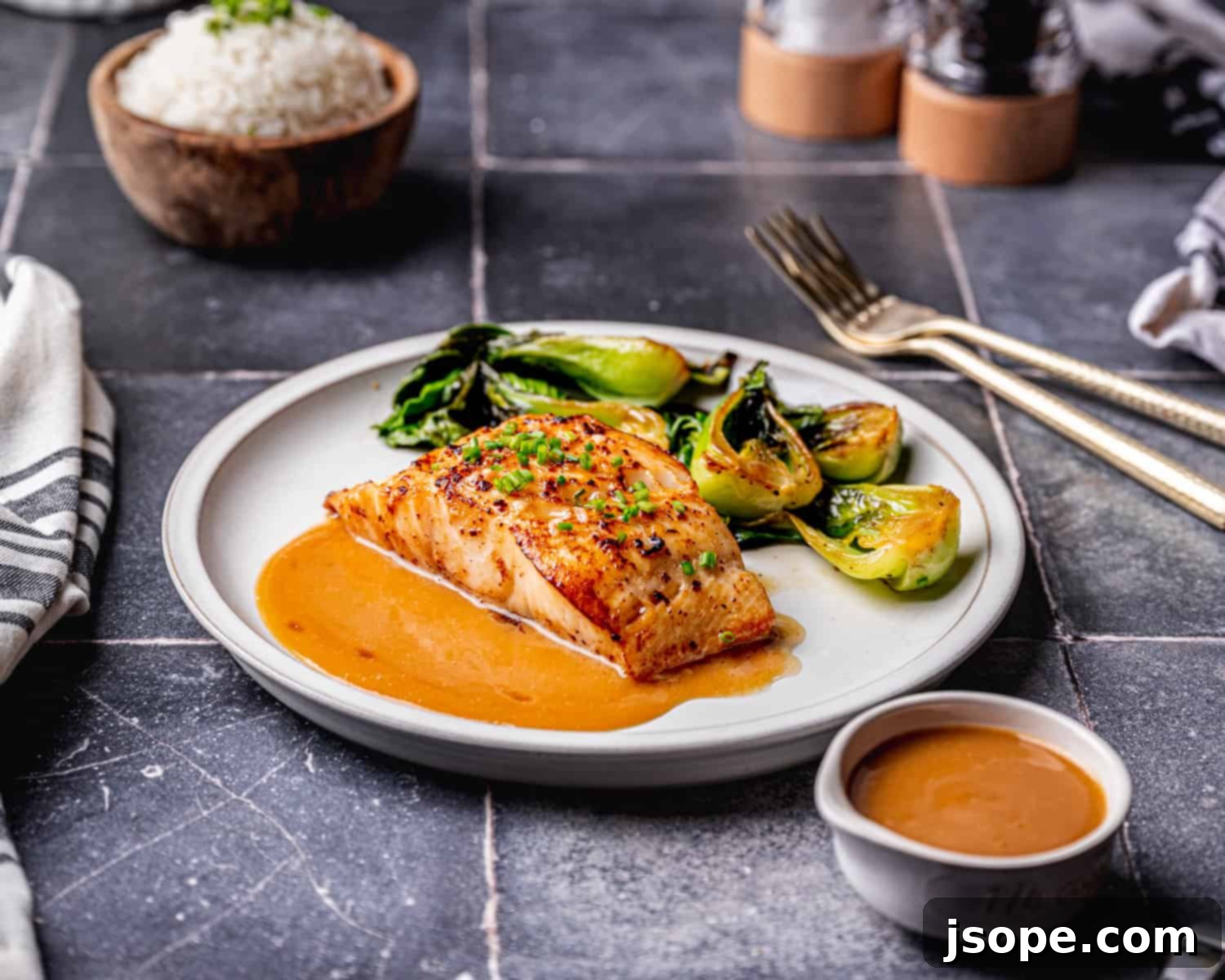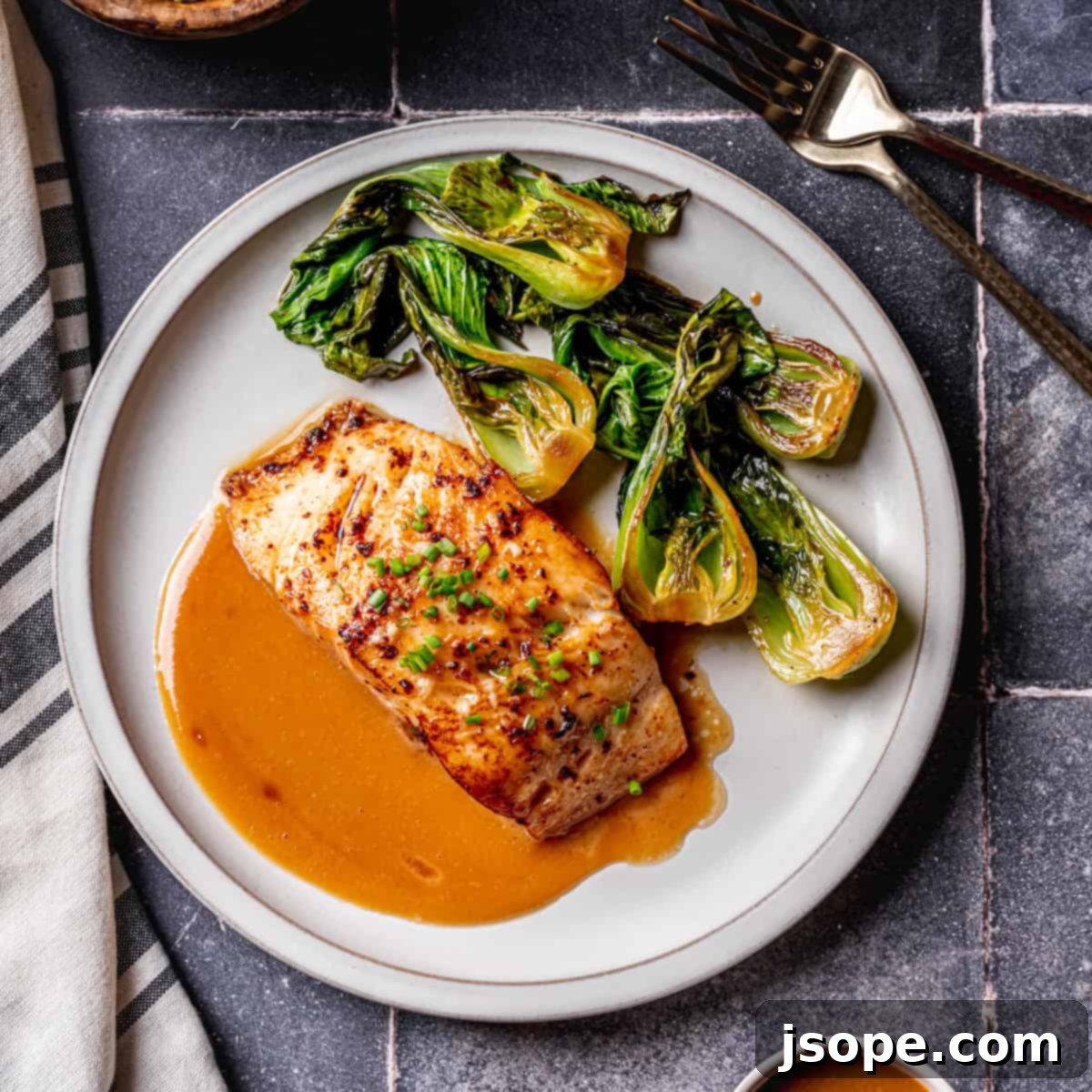Prepare to embark on a culinary journey with this exquisite Black Cod dish, a recipe so simple yet so profoundly elegant that it’s destined to become your go-to for special occasions, especially memorable date nights. Often hailed as one of the ocean’s most underrated treasures, sablefish – commonly known as black cod or butterfish – boasts a unique, succulent texture and delicate flavor that sets it apart from other fish. When this remarkable fish is expertly paired with an absolutely stunning miso and sake butter sauce, the result is an irresistible symphony of umami, savory, and subtly sweet notes that will leave you craving more, making it a dish you’ll want to recreate time and time again.
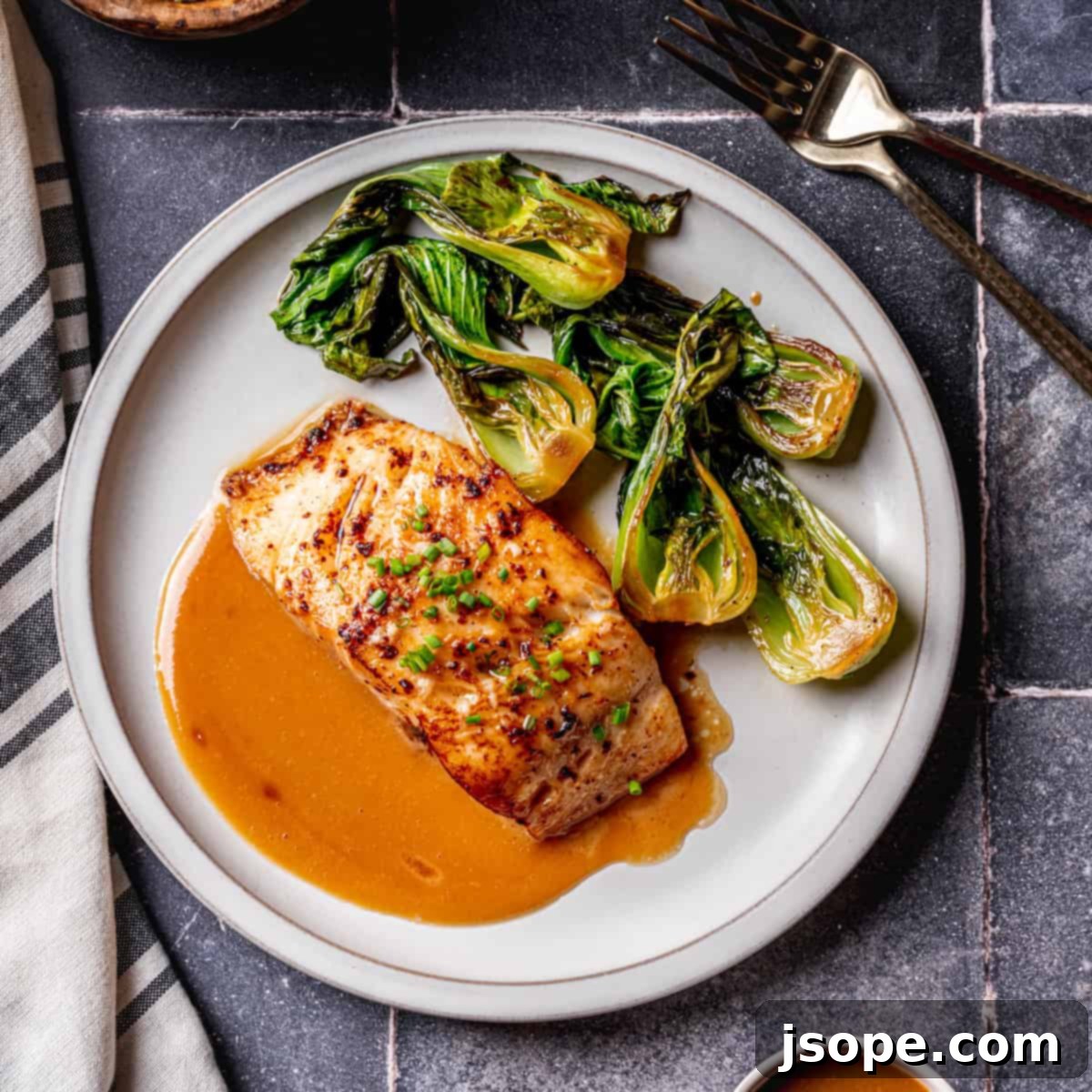
Craving more sophisticated seafood creations that delight the senses? Explore our other highly recommended recipes, such as the Crispy Parmesan Crusted Baked Cod, which offers a delightful crunch, or the vibrant Yellowtail with Lemon Caper Cream Sauce, a bright and zesty option perfect for any seafood enthusiast.
Table of Contents
- Why You’ll Love this Recipe
- What is Black Cod?
- Ingredients
- Substitutions
- How to Make Black Cod with Miso Butter Sauce
- Equipment
- Step-by-Step Instructions
- Variations
- Storage
- Top Tips
- Troubleshooting
- What to Serve with Black Cod and Miso Butter Sauce
- What Wines To Drink with Miso Butter Black Cod
- FAQ
- Related Recipes
- Pairing Suggestions
- Recipe Card
Why You’ll Love This Miso Butter Black Cod Recipe
This Roasted Black Cod with Miso Butter Sauce isn’t just a meal; it’s an experience. Here’s why this recipe will quickly become a cherished favorite in your culinary repertoire:
- An exquisite way to elevate your date night meal: Forget crowded restaurants and enjoy a gourmet experience right at home. This dish, with its sophisticated flavors and elegant presentation, feels incredibly special without requiring hours of complex cooking. It’s perfect for impressing a loved one or simply treating yourself to something truly extraordinary.
- Black cod tastes unlike anything else: Often called “butterfish” for a reason, black cod possesses an incredibly rich, buttery, and silky texture that melts in your mouth. Its delicate, slightly sweet flavor is truly unique, making it a standout among white fish. If you haven’t tried black cod before, prepare to be amazed by its luxurious mouthfeel and pristine taste.
- The flavor of the sauce is absolutely irresistible: This miso and sake butter sauce is a game-changer. Crafted in a manner similar to a classic French beurre blanc, it’s infused with profound umami flavors from the miso and a subtle depth from the sake. The resulting sauce is velvety smooth, perfectly balanced, and complements the black cod beautifully, making every bite a delight.
- This entire dish comes together quickly and easily: Despite its impressive taste and appearance, this recipe is surprisingly straightforward. With a prep time of just 30 minutes (mostly inactive chilling) and a cooking time of around 20 minutes, you can have a restaurant-quality meal on the table in under an hour. It’s perfect for busy weeknights when you still want something spectacular.
- Perfect for any special occasion or simply to treat yourself: While ideal for date night, this dish is versatile enough for any celebration, a sophisticated dinner party, or even a rewarding self-care meal after a long week. Its universal appeal lies in its combination of comfort and culinary elegance.
What is Black Cod (Sablefish / Butterfish)?
Black cod, scientifically known as sablefish (Anoplopoma fimbria), is truly in a class of its own. It’s celebrated for its remarkably high oil content, which contributes to its distinctively buttery, silky texture and a delicate, slightly sweet flavor. This dish will genuinely shock your palate with its nuanced profile and exquisite mouthfeel.
While once considered a hidden gem, black cod is thankfully becoming easier to find. You’ll typically have great success locating it in most Asian grocery stores, where it’s a staple. Its global fame, particularly the iconic miso black cod, largely stems from the culinary genius of Chef Nobu Matsuhisa. His renowned dish, a cornerstone of his Nobu restaurants worldwide, features black cod marinated in a sweet miso glaze (often referred to as Misoyaki butterfish in other Japanese establishments). This marinade imbues the fish with an unparalleled umami depth that has captivated diners for decades. Beyond the Nobu legacy, sablefish is cherished in many parts of the world, prepared in diverse and equally delicious ways.
If you encounter difficulty finding black cod at your local market, don’t despair! While we strongly encourage you to seek it out for the authentic, elevated experience this recipe promises, several excellent alternatives are listed below under our “Substitutions” section. For those committed to the real deal, black cod can often be sourced through reputable online seafood vendors. We’ve had consistent success ordering it HERE multiple times and have always been delighted with the quality. Additionally, keep an eye out for pre-frozen black cod fillets at larger warehouse stores like Costco. If all else fails, many local grocery store seafood counters can special order it for you, ensuring you have plenty of options to enjoy this magnificent fish.

Essential Ingredients for Miso Butter Black Cod
Crafting this delightful Black Cod with Miso Butter Sauce requires a selection of fresh, high-quality ingredients that harmonize to create its signature flavor. Here’s what you’ll need and why each component is crucial:
- Black Cod: Two 6-ounce fillets are ideal, preferably of similar size and uniform thickness to ensure even cooking. The skin should be removed, as the sauce is meant to envelop the delicate flesh. Black cod’s natural oils contribute significantly to the dish’s richness.
- Low Sodium Soy Sauce: A small amount is gently brushed onto the fillets before cooking. This initial application provides a foundational layer of savory flavor, tenderizes the fish slightly, and beautifully complements the profound umami of the miso butter sauce without overwhelming it with excessive saltiness.
- Olive Oil: Used to pan-sear the black cod, a small quantity of good quality olive oil prevents sticking and helps create a lovely golden-brown crust on the outside of the fish, adding texture and another layer of flavor before it finishes roasting.
- Sichuan Peppercorns: These unique peppercorns are dry-toasted to awaken their vibrant, citrusy, and slightly tingling flavor. They add a sophisticated aromatic complexity to the sauce, elevating it beyond a simple butter sauce.
- Black Peppercorns: Toasted alongside the Sichuan peppercorns, classic black peppercorns contribute a familiar, pungent warmth and subtle spice that balances the brighter notes of the Sichuan variety, adding depth to the sauce’s aromatic base.
- Shallot: Finely diced shallots are a crucial aromatic component for the sauce. They offer a milder, sweeter, and more delicate onion flavor compared to regular onions, forming a refined base that enhances the overall complexity of the sauce.
- Sake: We recommend using a dry, filtered Junmai sake for this recipe. Sake, a Japanese rice wine, adds a distinct umami note and aromatic elegance to the sauce, mirroring the flavors found in traditional Japanese cuisine. Its acidity helps to deglaze the pan and meld the flavors.
- White Miso Paste: Also known as “sweet miso” or “shiro miso,” this young, mild-flavored miso paste is widely available in Asian grocery stores. It’s the star of the sauce, providing that iconic umami depth and a subtle sweetness. It’s the same type of miso commonly used in classic miso soup, contributing a rich, savory body to the butter sauce.
- Lemon Juice: Just a touch of fresh lemon juice (from half a lemon) is essential. Its bright acidity cuts through the richness of the butter and miso, providing a crucial balance to the sauce and enhancing the overall flavor profile.
- Sweet Black Soy Sauce: A small amount of this viscous, slightly sweet, and intensely colored soy sauce adds a beautiful sheen and a profound depth of flavor to the sauce. It contributes a lovely caramel-like complexity and is also easily found at most Asian grocery stores.
- Unsalted Butter: The finishing touch for the sauce. Cold, diced unsalted butter is whisked in off the heat, creating a luscious, emulsified, and rich texture. This technique, similar to a beurre blanc, results in a glossy, umami-filled sauce that perfectly coats the delicate fish.
- Chives: Freshly chopped chives are used as a delicate garnish. Their mild oniony flavor and vibrant green color add a fresh finish and visual appeal to the plated dish.
Refer to the recipe card below for precise quantities and measurements.
Smart Substitutions for Miso Butter Black Cod
While black cod offers a truly unique experience, don’t let its availability deter you from trying this incredible sauce! Here are some practical substitutions for various ingredients in this recipe, allowing you to adapt it to your pantry and preferences:
- For Black Cod: If sablefish isn’t accessible, you have several excellent options. Halibut, Chilean sea bass, or even regular cod fillets are fantastic substitutes. Their firm, flaky white flesh will absorb the rich flavors of the miso butter sauce beautifully. Adjust cooking times according to the thickness of your chosen fillet; generally, thicker fish will require a bit more roasting time.
- For Sichuan Peppercorns: The Sichuan peppercorns add a unique citrusy, numbing sensation (mala). If you can’t find them, you can simply omit them without a significant downgrade in overall flavor. The sauce will still be delicious and flavorful, just without that distinct “mala” kick. Alternatively, a tiny pinch of red pepper flakes could add a hint of spice, though it won’t replicate the unique profile of Sichuan peppercorns.
- For Sake: A good quality dry white wine, such as a Sauvignon Blanc or Pinot Grigio, can be used in place of sake. It will provide similar acidity and depth to the sauce, resulting in a slightly different but equally delicious outcome. Avoid sweet wines, as they will alter the sauce’s balance.
- For White Miso Paste: To introduce a deeper, more robust flavor profile to your sauce, consider using red miso paste (aka “aka miso”). Red miso is aged longer, resulting in a saltier and more intensely savory taste. If you opt for red miso, be sure to taste the sauce as you go and adjust any added salt accordingly to prevent it from becoming too salty.
- For Shallot: A small amount of finely minced yellow onion can be used as a substitute for shallots. While shallots offer a more delicate and complex onion flavor, a yellow onion will still provide a good aromatic base for the sauce.
- For Lemon Juice: The acidity from lemon juice is key for balancing the rich sauce. However, you can experiment with other citrus fruits like lime, key lime, Meyer lemon, or even a small amount of orange juice for a slightly different aromatic twist. Since the sauce isn’t overly citrusy, any of these fruits will contribute a pleasant bright note.
- For Chives: Fresh green onions (scallions), thinly sliced, make an excellent substitute for chives as a garnish. They offer a similar mild onion flavor and vibrant green color, adding freshness and visual appeal to the finished dish.
Crafting Your Miso Butter Black Cod
This recipe is designed for efficiency and ease, allowing you to create a truly impressive dish without excessive effort. The beauty of this preparation lies in its streamlined process: you’ll roast the delicate black cod fillets while simultaneously preparing the luscious miso butter sauce. The most significant inactive time involved is simply allowing the seasoned fish to rest in the refrigerator for 30 minutes, a crucial step for enhancing flavor and texture before it hits the pan and oven. This synchronicity ensures a relatively quick turnaround for a meal that tastes like it took hours.
Essential Equipment for This Recipe
Having the right tools can make all the difference in ensuring a smooth cooking process and a perfect result. Here’s the equipment you’ll need for this black cod recipe, along with a brief explanation of why each is recommended:
- A small, shallow saucepan is ideal for creating the miso butter sauce. Its size allows for better control over the reduction and whisking of the butter.
- A fish spatula is highly recommended. Black cod is incredibly delicate once cooked, and a thin, flexible fish spatula allows you to gently transfer the fillets from the pan to the plate without breaking them.
- A mesh strainer will be essential for straining the sauce to achieve a beautifully smooth, refined consistency, removing any solids from the peppercorns and shallots.
- A ¼ sheet pan or rimmed baking sheet with a wire rack is needed for prepping the fish. Resting the fish on a wire rack allows air to circulate around it, ensuring the fillets dry evenly and achieve a better sear later.
- An oven-safe nonstick skillet is crucial for this recipe. It allows you to achieve a perfect pan-sear on the black cod before transferring it directly to the oven to finish cooking, minimizing cleanup and maximizing efficiency.
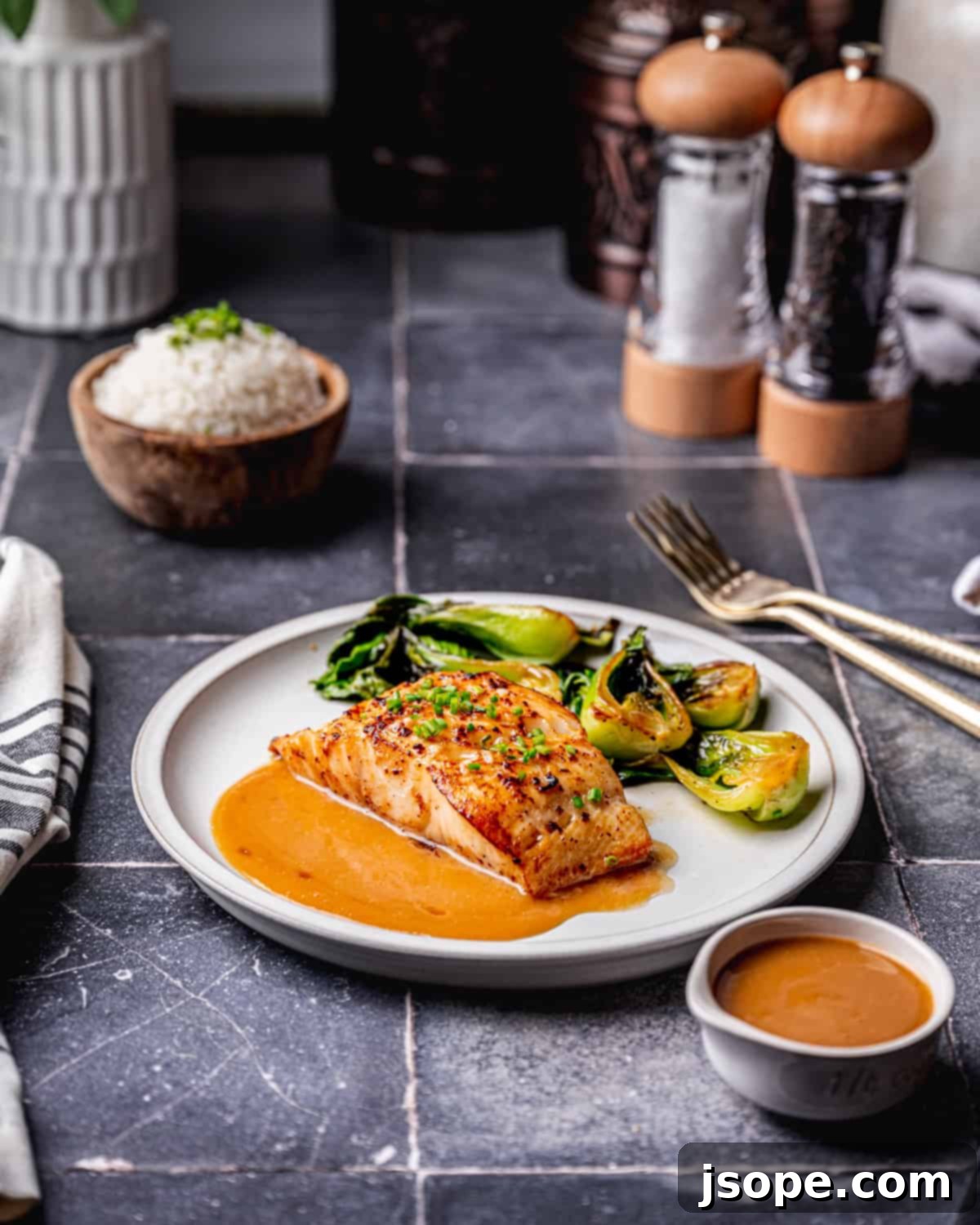
Step-by-Step Instructions: Mastering Miso Butter Black Cod
Follow these detailed steps to create a truly unforgettable black cod dish. Precision and timing are key to achieving perfect results.
Step 1: Prepare the Fish for Roasting
- Begin by thoroughly patting the black cod fillets dry with paper towels. This crucial step helps remove excess moisture, which is essential for achieving a nice sear later. If the skin is still on, use a very sharp knife to carefully remove it, or ask your fishmonger to do this for you.
- Brush both sides of the dried fillets evenly with the low-sodium soy sauce. This adds a foundational layer of savory flavor and helps to tenderize the fish.
- Place the seasoned fillets, skin-side down (if any residue remains), on a wire rack set over a sheet pan. Refrigerate them for 30 minutes. This resting period allows the soy sauce to penetrate and further enhances the fish’s texture.
- While the fish rests, preheat your oven to 425°F (220°C), ensuring it’s ready when the fish is.
Step 2: Begin Crafting the Miso Butter Sauce
- In a small, dry saucepan, combine both the Sichuan and black peppercorns. Place the saucepan over medium heat and toast the peppercorns, stirring frequently, until they become intensely fragrant. This usually takes about 1-2 minutes; be careful not to burn them.
- Once fragrant, reduce the heat to low and add the diced shallots to the pan. They might stick slightly initially, which is perfectly fine. Sauté for a minute or two until softened.
- Pour in the sake and stir, allowing it to deglaze the pan and incorporate the flavors.
- Next, add the white miso paste, fresh lemon juice, and sweet black soy sauce. Whisk continuously until all ingredients are fully incorporated and the sauce is smooth.
- Increase the heat back to medium and cook the sauce for approximately 3 minutes, allowing it to gently reduce and deepen in flavor.
- Carefully strain the sauce through a fine-mesh strainer into a clean bowl, discarding any solids (peppercorns and shallots). Return the smooth sauce to the saucepan and set aside off the heat until ready to finish.
Step 3: Sear and Roast the Black Cod
- Place an oven-safe nonstick skillet over medium heat and add the olive oil. Once the oil shimmers, carefully add the rested, soy-sauce-brushed black cod fillets to the hot pan, placing them flattest side down.
- Sear the fish for about 4 minutes until a beautiful golden-brown crust forms. This initial sear locks in moisture and adds a rich flavor.
- Without flipping the fish, transfer the skillet directly into your preheated 425°F (220°C) oven. Roast for 6-10 minutes, depending on the thickness of your fillets. The fish is cooked when it reaches an internal temperature of 145°F (63°C) and flakes easily with a fork.
- Once cooked, gently transfer the delicate fish fillets to individual plates using your fish spatula. Loosely cover them with aluminum foil to rest while you finalize the sauce. This resting period allows the juices to redistribute, keeping the fish moist.
Step 4: Finish the Sauce and Plate Your Dish
- While the fish is resting, place the saucepan with the strained sauce back over medium-low to low heat. Allow it to gently reduce further. The miso paste will naturally thicken the sauce, and the sake will continue to cook down, concentrating the flavors. You’re looking for a consistency that is thick enough to coat the back of a spoon, but still pourable.
- Once the sauce has reached your desired consistency, remove it from the heat. Gradually whisk in the cold, diced unsalted butter, one piece at a time. Whisk continuously until each piece of butter is fully incorporated, creating a glossy, emulsified, and rich sauce. The cold butter helps to create a stable emulsion, resulting in a perfectly velvety texture.
- Spoon a generous amount of the warm miso butter sauce over each rested black cod fillet.
- Garnish generously with freshly chopped chives for a pop of color and a fresh, mild oniony finish.
- Serve immediately with your favorite complementary side dishes (see “What to Serve” section for suggestions).
Creative Variations for Your Butterfish Recipe
This miso butter black cod recipe is incredibly versatile, offering ample room for creativity and customization. Here are a few exciting ways to adapt this butterfish recipe and tailor it to your taste or what you have on hand:
- Experiment with other white-fleshed fish: As mentioned in substitutions, this exquisite miso butter sauce pairs wonderfully with a variety of white-fleshed fish. Beyond halibut and Chilean sea bass, which are excellent choices due to their firm texture, we’ve also achieved fantastic results with more readily available options like cod (Atlantic or Pacific) and flounder. These fish absorb the sauce beautifully. Remember to simply adjust the cooking time based on the thickness of the fish fillets to ensure they are cooked through but remain moist and flaky. For a more adventurous twist, even fattier fish like salmon fillets or a robust mahi-mahi would be absolutely delicious with this umami-rich miso butter sauce, offering a different but equally compelling flavor profile.
- Deepen the sauce’s flavor with red miso: If you’re looking for a more intense, saltier, and profoundly savory sauce, swap the white miso paste for red miso paste. Red miso is aged longer, developing a more robust and complex flavor. When using red miso, be mindful of its inherent saltiness and adjust any additional soy sauce or salt in the recipe to taste. This variation will lend a bolder, more assertive character to your butter sauce, perfect for those who enjoy stronger umami notes.
- Add a hint of ginger or garlic: For an extra layer of aromatic complexity, consider adding a teaspoon of freshly grated ginger or finely minced garlic to the saucepan when you sauté the shallots. These ingredients will infuse the sauce with a warm, pungent undertone that harmonizes beautifully with the miso and sake.
- Introduce a touch of heat: If you enjoy a bit of spice, a small pinch of dried red chili flakes (gochugaru for a smoky, mild heat or a tiny pinch of cayenne for more intensity) can be added along with the peppercorns to the dry pan. This will introduce a subtle warmth that can complement the richness of the butter sauce.
- Herb it up: While chives are classic, you could experiment with other fresh herbs for garnish. A sprinkle of finely chopped cilantro or even thinly sliced basil could offer a fresh, aromatic counterpoint to the rich sauce, particularly if serving with Asian-inspired sides.
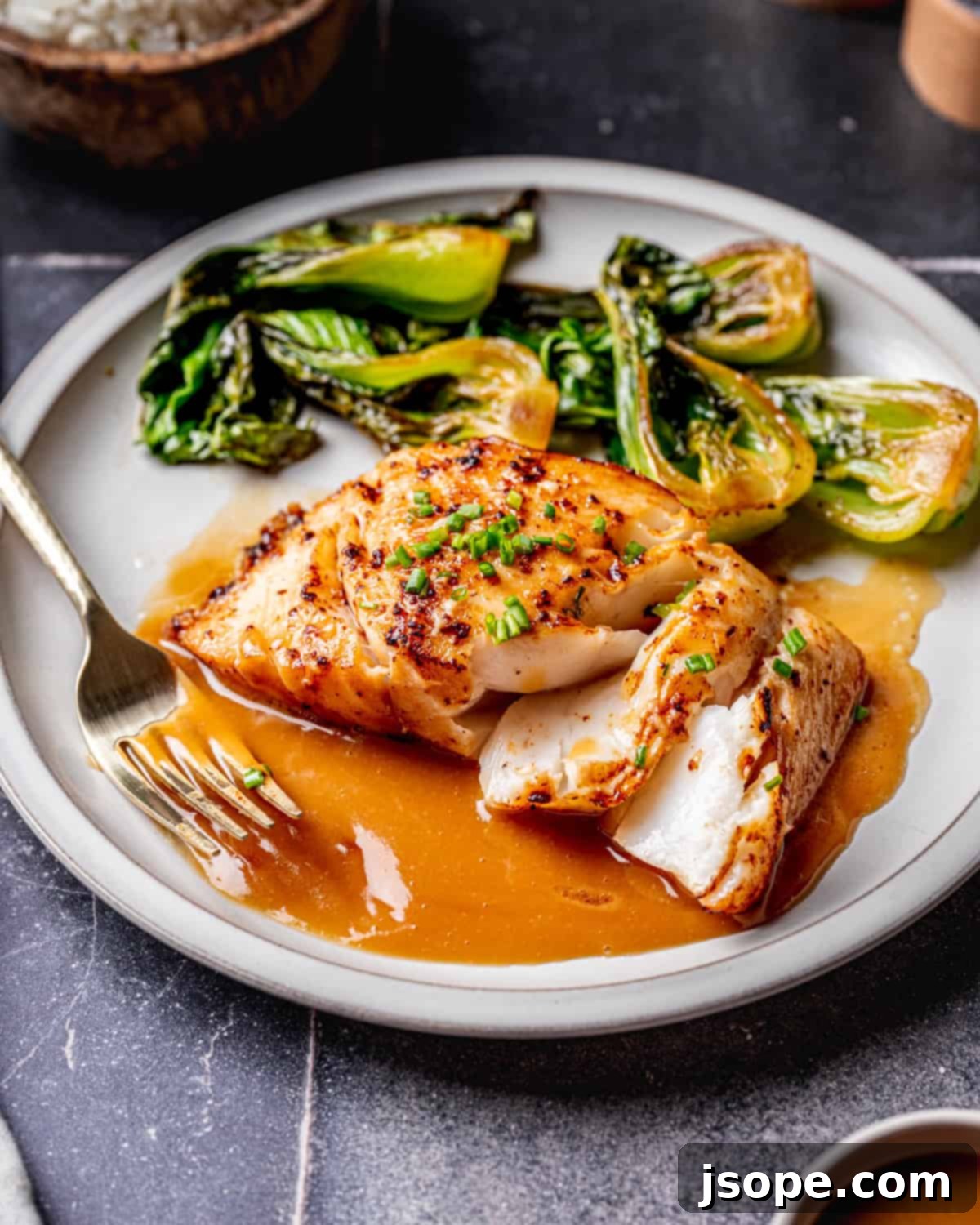
Storage and Reheating Tips for Black Cod
This dish is so delicious, it’s rare to have leftovers! However, if you find yourself with any, here’s how to properly store and reheat your black cod to maintain its quality.
How to store leftover black cod:
- If you do happen to have any leftover black cod, it’s best to store it promptly. Place the fish and any remaining sauce in a shallow, airtight container. Refrigerate immediately. Leftovers will maintain their best quality for up to 2 days when stored properly.
How to reheat leftover black cod:
- To reheat, place the cold cod fillets on a baking sheet. Preheat your oven to a gentle 325°F (160°C). Reheat the fish for about 10-15 minutes, or until it is warmed through to an internal temperature of 145°F (63°C). Be careful not to overcook, as this can dry out the delicate fish. A gentle reheat ensures it remains moist and flavorful.
- Alternatively, you can gently warm it in a non-stick skillet over very low heat with a lid, adding a tablespoon of water or broth to create steam and prevent drying.
Can you freeze leftover black cod?
- Freezing cooked black cod is generally not recommended. The delicate texture of black cod can become rubbery or mushy after thawing, and the sauce may separate. This dish is best enjoyed fresh or within a couple of days from the refrigerator.
Chef’s Top Tips for Perfect Miso Butter Black Cod
Achieving restaurant-quality results with this dish is simpler than you think with a few clever strategies:
- Prepare the sauce in advance for a stress-free experience: This is a fantastic time-saving tip! You can make the miso butter sauce almost entirely ahead of time. Prepare the sauce up to the point of straining it, and then simply let it sit off the heat. When you’re ready to cook, begin preparing your fish. Once the fish starts cooking, you can gently reheat and reduce your prepared sauce. By the time your black cod is perfectly cooked and resting, all you need to do is whisk in the cold butter to finish the sauce, making for a seamless and calm plating experience.
- Enhance flavor and texture by chilling the fish: Just like with other delicate proteins, allowing the black cod fillets to sit on a wire rack over a sheet tray in the refrigerator for at least 30 minutes (after seasoning with soy sauce) is a game-changer. This process, often called “dry brining” or “air-drying,” helps to draw out excess moisture from the surface of the fish, leading to a much better sear and a crispier exterior while ensuring the interior remains incredibly moist and flaky. Don’t skip this step – it makes a noticeable difference!
- Don’t overcrowd the pan: When searing the fish, make sure to use a skillet large enough to accommodate the fillets without crowding them. Overcrowding lowers the pan’s temperature, steaming the fish instead of searing it, which prevents the formation of that beautiful golden crust.
- Use cold butter for a glossy sauce: When finishing the sauce, ensure your butter is cold and diced into small pieces. Adding cold butter gradually while whisking vigorously off the heat is the secret to creating a stable, emulsified, and beautifully glossy beurre blanc-style sauce.
Common Troubleshooting for Black Cod
Even experienced cooks can encounter minor hiccups. Here are solutions to some common issues you might face when preparing this delicate dish:
- Delicate fish handling: Most fish, especially black cod, are inherently delicate. Cooked black cod is particularly tender and can flake easily. Exercise extreme caution when turning the fish in the pan and, especially, when transferring it from the roasting pan to the serving plate. This is precisely why a fish spatula is an invaluable tool here – its thin, wide, and flexible blade allows you to scoop and support the entire fillet without it breaking apart.
- Sauce consistency issues (too thick or too thin):
- If your sauce is too thick: The miso paste can sometimes cause the sauce to thicken more than desired during reduction. If you find your sauce is overly thick and not easily pourable, don’t worry. Simply add a small touch of warm water or a splash of sake (or white wine) and whisk gently until it reaches your preferred consistency. You want the sauce to be thick enough to coat the back of a spoon but still flow smoothly.
- If your sauce is too thin: If the sauce seems too watery, return it to very low heat and continue to gently simmer, stirring occasionally, until it reduces further and thickens. Be patient, as aggressive boiling can sometimes break an emulsion.
- Fish sticking to the pan: Ensure your oven-safe nonstick skillet is properly preheated and has a sufficient, thin layer of olive oil. The “dry brining” step also helps prevent sticking by removing surface moisture. If the fish starts to stick, avoid forcing it; often, if it’s not ready to release, it needs another 30 seconds to form a proper crust.
Perfect Pairings: What to Serve with Black Cod and Miso Butter Sauce
The rich, umami-laden flavors of this black cod dish shine brightest when paired with thoughtful side dishes that complement without overwhelming. Here are some of our favorite recommendations to create a complete and harmonious meal:
- Steamed Jasmine Rice with Coconut Milk: It’s truly difficult to beat the classic pairing of perfectly steamed jasmine rice. For an added layer of aroma and subtle sweetness that perfectly complements the miso, cook your jasmine rice with a touch of coconut milk. The creamy, fragrant rice provides a wonderful canvas for the rich sauce.
- Baby Bok Choy: This Asian green is an excellent addition. We love to pan-cook baby bok choy with a touch of olive oil until tender-crisp. Finish it with a squeeze of fresh citrus (lemon or lime) and a dash of soy sauce for a bright, savory, and healthy contrast to the buttery fish. Its mild bitterness and tender texture are ideal.
- Roasted Asparagus: Simple roasted asparagus spears, tossed with a little olive oil, salt, and pepper, offer a lovely green crunch and earthy flavor that pairs well with almost any fish.
- Sautéed Green Beans with Sesame: Fresh green beans quickly sautéed with a hint of garlic and a drizzle of sesame oil and toasted sesame seeds add a fantastic texture and an Asian-inspired flavor profile.
- Miso Glazed Eggplant: For another layer of umami, thinly sliced eggplant brushed with a simple miso glaze and roasted until tender would be a decadent and flavorful side.
- Simple Green Salad: A light, crisp green salad with a ginger-sesame vinaigrette can provide a refreshing counterpoint to the richness of the main dish.
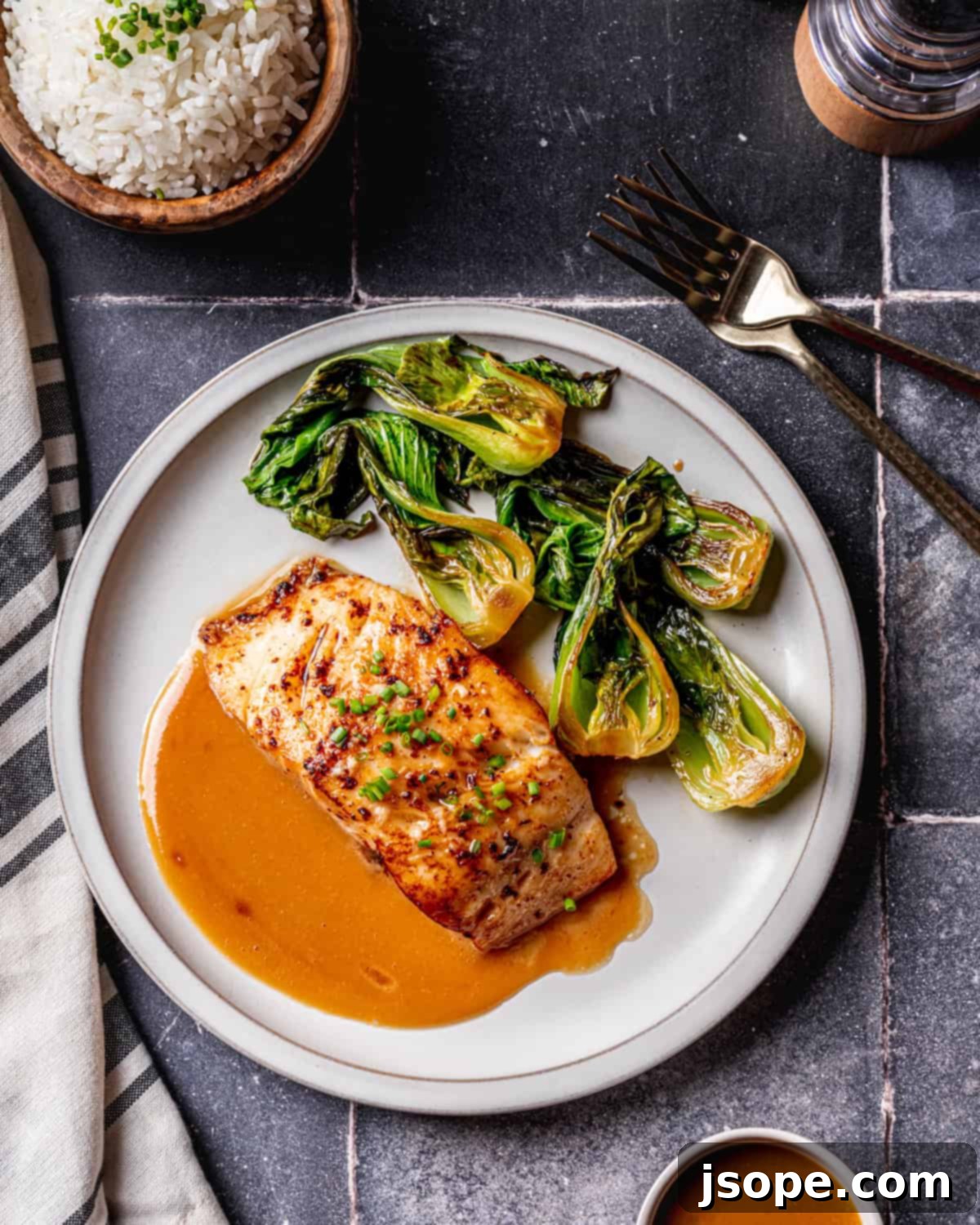
Exquisite Wine Pairings for Miso Butter Black Cod
Selecting the right beverage can elevate your dining experience, and this Miso Butter Black Cod is no exception. Its rich, umami, and subtly sweet profile pairs beautifully with specific wine styles:
- Dry Sake (Junmai): Our absolute top recommendation for this miso butterfish dish is a nice, dry sake, particularly a Junmai grade. The natural umami in sake perfectly mirrors and enhances the umami in the miso sauce. Its crisp, clean profile and subtle rice notes harmonize exquisitely with the delicate butteriness of the black cod. Plus, since you’re already using sake for the sauce, a bottle won’t go to waste!
- Off-Dry Gewürztraminer: This aromatic white wine, with its characteristic notes of lychee, rose, and ginger, and a slight hint of sweetness, is a fantastic choice. The off-dry (slightly sweet) quality of Gewürztraminer beautifully balances the savory umami of the miso, while its aromatic complexity complements the subtle spices in the sauce.
- Dry to Semi-Dry Riesling: A versatile and elegant pairing, a dry or semi-dry Riesling (especially from regions like Alsace or Australia) offers bright acidity and notes of green apple, lime, and sometimes a hint of petrol. Its crispness cuts through the richness of the butter sauce, and its aromatic qualities complement the fish without overpowering it. A semi-dry Riesling can also echo the subtle sweetness of the black cod itself.
- Unoaked Chardonnay: If you prefer a more traditional white wine, an unoaked Chardonnay is a safe and satisfying bet. Look for one with bright acidity and crisp fruit flavors that can cut through the richness of the sauce without adding competing oaky notes.
- Albariño: This Spanish white wine is known for its vibrant acidity, saline minerality, and notes of stone fruit and citrus. It offers a refreshing contrast to the richness of the dish and pairs wonderfully with seafood.
Frequently Asked Questions About Black Cod
Yes, black cod, sablefish, and butterfish are all common names used interchangeably in North America to refer to the same species of fish, Anoplopoma fimbria. The nickname “butterfish” is a nod to its exceptionally rich, buttery texture and high oil content.
Black cod is truly special due to its unique combination of texture and flavor. Its flesh is incredibly buttery and silky, almost melting in your mouth, which is why it earned the moniker “butterfish.” Unlike many other fish that can dry out, black cod retains remarkable juiciness while flaking beautifully. Its flavor is delicate, sweet, and rich, making it a highly prized ingredient in fine dining and home kitchens alike.
Miso paste is a traditional Japanese seasoning made from fermented soybeans. Salt and koji (a fungus) are essential components in the fermentation process, and sometimes other ingredients like rice or barley are also added. The fermentation duration largely determines the color and flavor intensity; younger, shorter-fermented miso (like white miso) is milder and sweeter, while longer-aged miso (like red miso) is richer, saltier, and more complex.
Absolutely! Black cod is not only delicious but also very healthy. It’s an excellent source of omega-3 fatty acids, which are beneficial for heart health and brain function. It’s also high in lean protein, vitamin D, and selenium, making it a nutritious choice for any diet.
Yes, you can certainly use high-quality frozen black cod fillets for this recipe. Ensure they are thawed completely in the refrigerator overnight before use. Pat them very dry with paper towels to remove any excess moisture before seasoning and searing, as this will help achieve the best possible texture.
More Delicious Seafood Recipes to Explore
If you’ve enjoyed this delightful black cod dish and are eager for more culinary adventures with seafood, be sure to try these other fantastic recipes from our collection:
- Oven Roasted Bourbon Brown Sugar Glazed Salmon
- Shrimp with Spicy Vodka Sauce (Shrimp alla Vodka)
- Oven Roasted Cod with Calabrian Chili Butter Sauce
- Easy Roasted Black Cod (Butterfish) with Miso Butter Sauce
Perfect Side Dish Pairings
These are our favorite and most recommended side dishes to serve alongside this exquisite Miso Butter Black Cod, ensuring a well-rounded and delicious meal:
- Easy Sautéed Balsamic Asparagus with Parmesan
- Sheet Pan Chickpea and Vegetable Medley Dinner
- Garlic Thyme Smashed Potatoes
- Dover Sole with Lemon Risotto
📖 Recipe Card
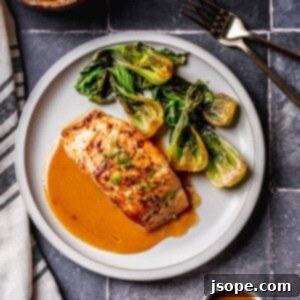
Roasted Black Cod with Miso Butter Sauce
Pin Recipe
Equipment
- 1 small saucepan
- 1 baking sheet with wire rack
- 1 fish spatula
- 1 oven-safe nonstick skillet
- 1 fine mesh strainer
Ingredients
- 2 Black Cod fillets roughly 6 oz each, skin removed
- 2 Tablespoons soy sauce (low sodium)
- 1 Tablespoon olive oil
- 10 Sichuan peppercorns whole
- 10 Black peppercorns, whole
- 1 medium shallot diced small
- ¾ cup sake Junmai or other dry filtered sake is best here
- 1 Tablespoon white miso paste
- Juice of ½ of a medium lemon
- ½ teaspoon sweet black soy sauce
- 4 Tablespoons unsalted butter – cold and diced
- chives for garnish
Instructions
- Pat the fish fillets dry with a paper towel. Remove the fish skin with a very sharp knife or have it removed at the market. Brush the fillets with the soy sauce and place on a wire rack (skin side down) over a sheet pan and refrigerate for 30 minutes. Preheat the oven to 425°F (220°C).2 Black Cod fillets, 2 Tablespoons soy sauce (low sodium)
- For the sauce, add both types of peppercorns to a dry saucepan over medium heat. Once the peppercorns become quite fragrant (a couple of minutes), reduce the heat to low and add the shallots. They may stick to the pan at first, but that is fine. Add the sake and stir. Next add the miso paste, lemon juice and black sweet soy sauce and whisk until fully incorporated. Turn the heat back up to medium and cook for 3 minutes. Strain the sauce through a fine mesh strainer and return the smooth sauce to the saucepan without any solids.10 Sichuan peppercorns, 10 Black peppercorns. whole, 1 medium shallot, ¾ cup sake, 1 Tablespoon white miso paste, Juice of ½ of a medium lemon, ½ teaspoon sweet black soy sauce
- In an oven-safe nonstick skillet over medium heat, add the olive oil. Once shimmering, add the fish that has been brushed with soy sauce and has rested in the refrigerator. Cook for about 4 minutes with the flattest side down until golden brown. Then, transfer the skillet with the fish to the preheated oven for 6-10 minutes, depending on the thickness of your fillets. The internal temperature should reach 145°F (63°C). Once the fish is done, gently transfer the fillets to plates and loosely cover with aluminum foil to rest while you finish the sauce.1 Tablespoon olive oil
- While the fish is cooking and resting, reduce the sauce over medium-low to low heat. It will become thicker (from the miso paste) and the sake will cook down. Once the fish is done and resting, remove the reduced sauce from the heat and whisk in the cold butter, one piece at a time, until fully incorporated and the sauce is glossy and smooth. Serve the black cod immediately with the miso butter sauce and garnish with chives. Serve with your favorite side dishes.4 Tablespoons unsalted butter – cold and diced
Nutrition
Carbohydrates: 13g
Protein: 30g
Fat: 31g
Saturated Fat: 16g
Polyunsaturated Fat: 2g
Monounsaturated Fat: 11g
Trans Fat: 1g
Cholesterol: 140mg
Sodium: 1442mg
Potassium: 571mg
Fiber: 1g
Sugar: 3g
Vitamin A: 724IU
Vitamin C: 6mg
Calcium: 44mg
Iron: 1mg
